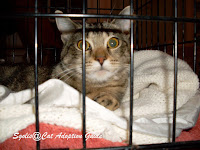Keep your outdoor cats safe from wind, rain, hail, extreme heat and cold with a kitty tube cat house. This tube will provide
your cat with a comfortable outdoor resting place. The interior is roomy; three cats
can sleep comfortably.
 |
If you are providing your indoor/ outdoor cat with a kitty tube cat house then set it up on your porch, patio, or deck. However
if you intend to provide stray or feral cats with an outdoor cat house then you will need to choose an area that is away from human
traffic.
A good location for the kitty tube would be behind evergreen shrubs or tucked under bamboo or ornamental grass. Any location that is quite and hidden is ideal for a feral cat house.
A good location for the kitty tube would be behind evergreen shrubs or tucked under bamboo or ornamental grass. Any location that is quite and hidden is ideal for a feral cat house.
If you reside in an area that gets snow and heavy
rain then elevate the kitty tube.
The higher elevation protects the cat and bedding from water drainage and snow. If you do not have higher ground then build a platform base of cement blocks and then set plywood that is an inch thick on top of the cement block.
The higher elevation protects the cat and bedding from water drainage and snow. If you do not have higher ground then build a platform base of cement blocks and then set plywood that is an inch thick on top of the cement block.
Tips:
The kitty tube comes with a thermal pad. Feral cats are more accustomed to straw than they are to a thermal pad. They prefer to burrow into straw and then
sleep. I removed the pad and gave it to my indoor cats. I then filled the kitty tube with straw. Feral cats tend to mark the straw. You will need to check the straw bedding and if it soiled then remove and add fresh straw to the cat house.
Secure the kitty tube with bungee cords. This will protect the cat house from being
uplifted when there is a strong wind.
The door design on the kitty tube provides easy passage for your cat and keeps predators out.
The tube is a safe and secure place for outdoor
cats to give birth.

